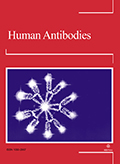Authors: Shoji, Masahiro | Kawamoto, Seiji | Seki, Kiyohiko | Teruya, Kiichiro | Setoguchi, Yuko | Mochizuki, Katsumi | Kato, Masatoshi | Hashizume, Shuichi | Hanagiri, Takeshi | Yoshimatsu, Takashi | Nakanishi, Kozo | Yasumoto, Kosei | Nagashima, Akira | Nakahashi, Hisashi | Suzuki, Tatsuo | Imai, Tadaaki | Shirahata, Sanetaka | Nomoto, Kikuo | Murakami, Hiroki
Article Type:
Research Article
Abstract:
Human monoclonal antibody (hMAb) AE6F4 has been shown to be potentially useful for immunocytological detection of lung cancer cells in sputum. By recombinant DNA technology, IgM type hMAb AE6F4 was switched to IgG. The IgG mimic recombinant AE6F4 antibody expression plasmid was assembled using the antibody heavy chain gene, which ligated the gene encoding VH and CH 1 (μ) domains of hMAb AE6F4 heavy chain to the gene encoding CH 2(γ 1) and CH 3(γ1) domains of human IgG heavy chain, and the antibody light chain gene of hMAb AE6F4. The recombinant antibody expressed by baby hamster kidney (BHK)
…– 21 cells showed molecular size equivalence to IgG, and consisted of human μ–γ hybrid heavy and κ light chains. The immunological specificity of the recombinant antibody was the same as that of hMAb AE6F4 by immunoblotting analysis to the 14–3–3 protein, the putative antigen of hMAb AE6F4, and by immunohistochemical and immunocytological analyses using tissue sections and sputa of lung cancer patients. The transfected BHK-21 cells produced the recombinant antibody persistently and the productivity was greater than 20 times that by human-human hybridoma producing hMAb AE6F4.
Show more
Keywords: Human monoclonal antibody, recombinant antibody, lung cancer, baby hamster kidney cells, diagnostics
DOI: 10.3233/HAB-1996-7104
Citation: Human Antibodies,
vol. 7, no. 1, pp. 27-36, 1996
Price: EUR 27.50





